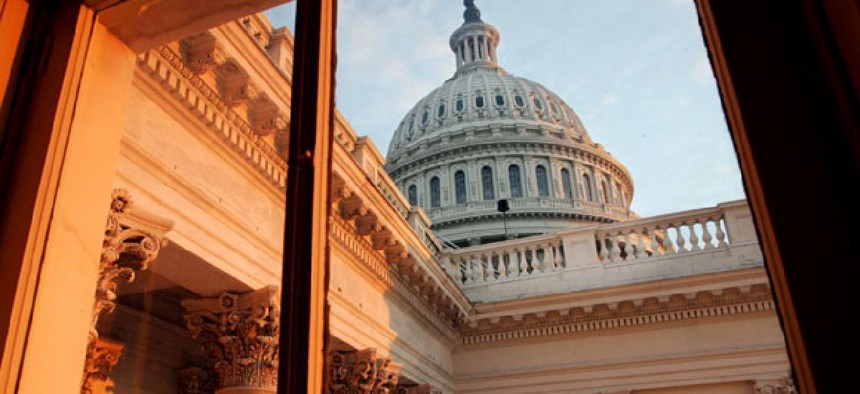One might have expected that two years after Republicans picked up 63 House seats—the biggest gain in a midterm election since 1938—Democrats would be on track to win back a boatload of those districts that the GOP didn’t have much business winning in the first place. But a little more than four months out from the election, the tides seem about as neutral as they can be. Both parties have surprisingly comparable levels of exposure, largely because of redistricting. The relatively calm surface of this year’s waters belies a lot of offsetting tumult and change underneath. But for House Republicans, who hold a 25-seat majority, a status quo election producing minimal net change would be good news.
At this point in the past three “wave” election cycles—the great Democratic years of 2006 and 2008 and the monumental GOP year of 2010—two things were true: First, one party had nearly all the momentum; every week a new strong candidate emerged or a new, surprising district came into play. Second, Tip O’Neill’s “all politics is local” adage had left the building. Voters focused almost entirely on sending a national message, opposing President Bush in 2006 and 2008, and then President Obama in 2010. It didn’t matter that Democrat Alan Grayson (FL-08) had attended CodePink rallies before running in 2008, or that Republican Joe Walsh (IL-08) was railing against Washington for spending beyond its means, while a bank foreclosed on his condo in 2009. They both won. Likewise, it didn’t matter that Republican Christopher Shays (CT-04) had worked closely with Democrats on campaign finance reform or that Democrat Gene Taylor (MS-04) had voted to the right of many (if not most, at one point) Republicans in the House. They both lost.
If anything, this year feels like a weird hybrid. On one hand, neither party can claim broad momentum; developments in House races are tit for tat. One week, Rep. Thaddeus McCotter, a Michigan Republican and former hopeless presidential aspirant, announced he had failed to file the requisite 2,000 signatures to seek reelection. He sent his party scrambling. Democrats, though, suffered their own embarrassment in California. The new top-two primary system enabled a pair of Republicans to close the door on promising Redlands Democratic Mayor Pete Aguilar and his party’s chances of winning a new Latino majority seat in San Bernardino. The same night that Democrat Ron Barber, the former aide to retired Rep. Gabrielle Giffords, won a contested special election in Arizona, the party lost its favored candidates in the Arkansas and South Carolina primaries. (It is doubtful, though, that Democrats would have been competitive in those districts.)
But on the other hand, House races still feel as nationalized and parliamentary as they were in the past three elections. It’s just that the contests are bifurcating into one of two universes, depending on where they are on the map. In one set of districts—think better-educated, suburban, younger, and more diverse—the slightest rebound toward 2008 turnout levels appears likely to sink GOP Reps. Joe Walsh (IL-08), Roscoe Bartlett (MD-06), and Ann Marie Buerkle (NY-25). In another set—think high school diplomas, rural, older, and whiter—the environment still looks a lot like 2010, and antipathy toward Obama is likely to cost Democrats as many as six open seats ranging from southern Arkansas, to western North Carolina, to eastern Oklahoma and southern Illinois.
Were this election not immediately following a largely GOP-controlled round of redistricting, Democrats might have far fewer vulnerabilities of their own and many more appetizing Republican targets. But after Kansas became the last state to finalize its congressional lines earlier this month, the distribution of new districts told a scary before-and-after tale for Democrats. Using The Cook Political Report’s Partisan Voter Index as a measuring stick, our preliminary analysis indicates that the number of strongly Democratic districts—those with a score of D+5 or greater at the presidential level—decreased from 144 before redistricting to 136 afterward. The number of strongly Republican districts—those with a score of R+5 or greater—increased from 175 to 183. When one party starts out with 47 more very strong districts than the other, the numbers suggest that the fix is in for any election featuring a fairly neutral environment. Republicans would need to mess up pretty badly to lose their House majority in the near future.
An analysis of the race-by-race landscape tracks the partisan data pretty closely. The Cook Political Report rates 211 House seats as solid or likely Republican, compared with 171 as solid or likely Democratic. If the 24 toss-up races split evenly between the parties, Democrats would score a net gain of just a single seat. Even if Democrats held everything in their solid, likely, and lean columns and also won every toss-up, they would still need to take two-thirds (12 of 18) of the districts rated lean Republican to win a majority. That’s a pretty unlikely scenario, absent a strong wind at their backs.
Minimal partisan change doesn’t preclude significant change in the House’s makeup, however. In 2008, 85 members won “crossover” districts that voted for one party for the House and the other way at the presidential level. Unsurprisingly, these members show the greatest proclivity to think independently and have the most incentive to compromise. But in 2010, this number was cut in half to 40. In 2012, it could be cut in half yet again to fewer than 20.
If you’re waiting for a retreat of tea party politics in the House Republican Conference and a resurgence of Blue Dog Democrats in the next Congress, you are likely going to be disappointed.
David Wasserman contributed to this column.



